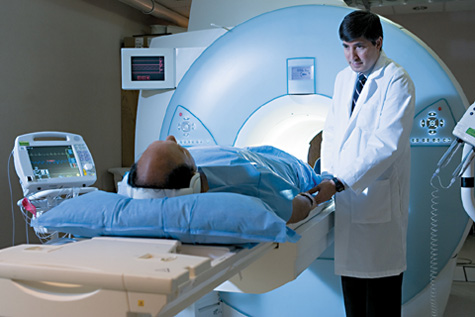What To Expect During Cardiac MRI
Magnetic resonance imaging (MRI) machines are
usually located at a hospital or at a special medical imaging facility. A
radiologist (ra-de-OL-o-jist) or other physician with special training in
medical imaging oversees MRI testing.
Cardiac MRI usually takes 45 to 90 minutes,
depending on how many images are needed. The test may take less time with some
newer MRI machines.
The MRI machine will be located in a specially
constructed room. This will prevent radio waves from disrupting the machine and
will prevent the strong magnetic fields generated by the MRI machine from
interfering with other equipment.
Traditional MRI machines look like a long, narrow
tunnel. Newer MRI machines called short-bore systems are shorter, wider, and
don’t completely surround you. Some of the newer machines are open on all
sides. Your doctor will help decide which machine type is best for you.
Cardiac MRI is painless and harmless. You will lie
on your back on a sliding table that goes inside the tunnel-like machine. The
technician will control the machine from the next room. He or she will be able
to see you through a glass window and will be able to talk to you through an
intercom system. Tell the technician if you have a hearing problem.
A Patient Having Cardiac MRI

The photo shows a patient lying on a
sliding table outside of a cardiac MRI machine. The table will slide into the
machine, and the patient will lie quietly while pictures of the heart are
taken.
The MRI machine makes loud humming, tapping, and
buzzing noises. Earplugs may help lessen the noises made by the MRI machine.
Some facilities let you listen to music during the test.
Remaining very still during the test is important.
Any movement may blur the images. If you’re unable to lie still, you may
be given medicine to help you relax. You may be asked to hold your breath for
10 to 15 seconds at a time while the technician takes pictures of your heart.
Researchers are studying ways that will allow someone having a cardiac MRI to
breathe freely during the exam, while achieving the same image quality.
A contrast dye, such as gadolinium
(gad-oh-LIN-ee-um), may be used to highlight your blood vessels or heart in the
images. Contrast dye is usually injected into a vein in your arm with a needle.
You may feel a cool sensation during the injection, and you may feel discomfort
where the needle was inserted. Gadolinium doesn’t contain iodine so it
won’t create problems for people who are allergic to iodine.
If your cardiac MRI includes a stress test to detect
blockages in your coronary arteries, you will receive other medicines to
increase the blood flow in your heart or to increase how fast your heart
beats. |

